The CitiCAP (citizens' cap and trade co-created) Project Zoom In 2
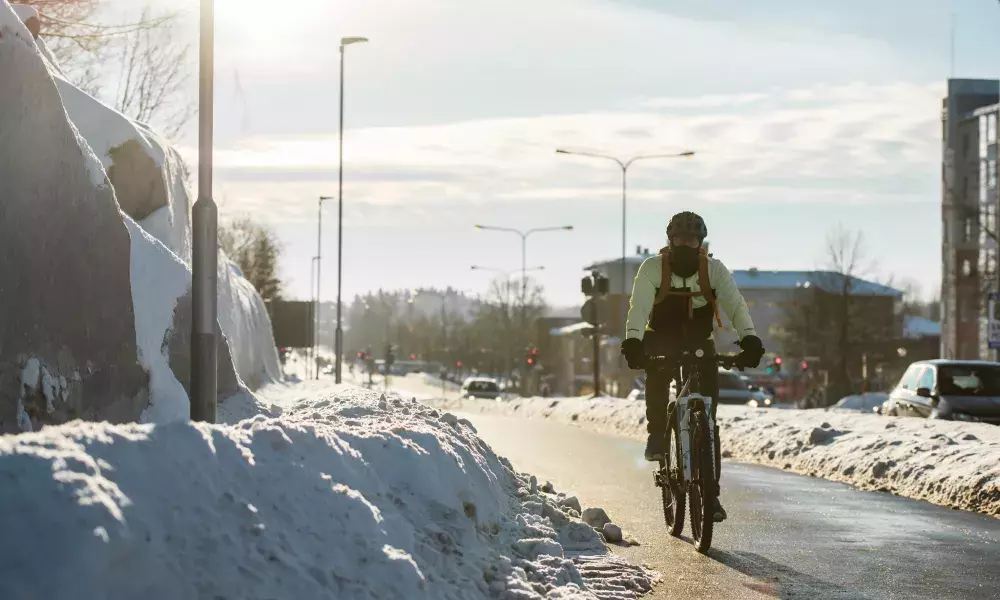
The principle of co-creation is the process of creating new public policies and services with people and not for them. This is an essential element of the SUMP and Master Planning process so this Zoom-In also focuses on the co-creation aspect that the city has taken and will outline some insights and case studies that cities have used to engage citizens which verifies the CitiCAP approach.
Context
Compact cities prioritise access for people to goods and services. People in compact cities (or compact city centres) have a higher propensity to walk and bicycle, not out of compulsion but because the conditions support walking, cycling and public transport. Compact cities, encourage walking and cycling primarily through better land-use policies that favour higher density, diverse land use and a design favouring walking and cycling enabling better access to public transport. By influencing the spatial structure of locations in the urban environment, land use planning can contribute to reducing vehicle kilometres travelled resulting in less congestion, pollution and emissions - a key objective of CitiCAP. Transport policies that encourage walking, cycling and public transport, support compact city structure and contain the trips within the city. That is why it is so important to link land use planning with transport policy. The SUMP process aims to bring these two elements together and is why the European Commission encourages their uptake in urban areas across the region but does not prescribe how this should be done.
The European Commission encourages cities, notably through EU Projects like CitiCAP as well as through guidance, to scale up efforts to make public services user-friendly and reduce the administrative burden as studies show that service design often does not meet the expectations of citizens and businesses, who require more usability, responsiveness and transparency, reflecting the different needs of users and the variety of activities public services encompasses. Weak service design, planning and high administrative burden often leads to non-use or non-take up by citizens and businesses of public services and the benefits available to them. This is why the co-creation aspect is so fundamental to the success of the CitiCAP project.
The profound understanding of end users, including specific groups, are an important element of SUMP development but also other elements of CitiCAP, such as the personal carbon trading scheme, because if it is to be successful the city will need to meet the sustainable mobility needs of citizens and businesses so that they do not have to rely on private cars. Co-creation of public services in this context is a public service that is provided by government, citizens, NGOs, private companies or individual civil servants, in collaboration with government institutions, based on government or non-government data or services. It requires public service actors to engage with stakeholders in the design, production and delivery phases of SUMPs, to gather the necessary user insight, re-define their operational processes and identify appropriate sustainability models to deliver an effective high quality mobility service, which is different to a ‘simple’ stakeholder consultation process. This is why the Commission encourages cities to adopt such approaches but SUMPs are not mandatory in Finland. Cities therefore need to look at innovative ways to integrate them into their formal governance structures and processes which this Zoom In will focus on.
The CitiCAP Master Planning & SUMP process - what has been done
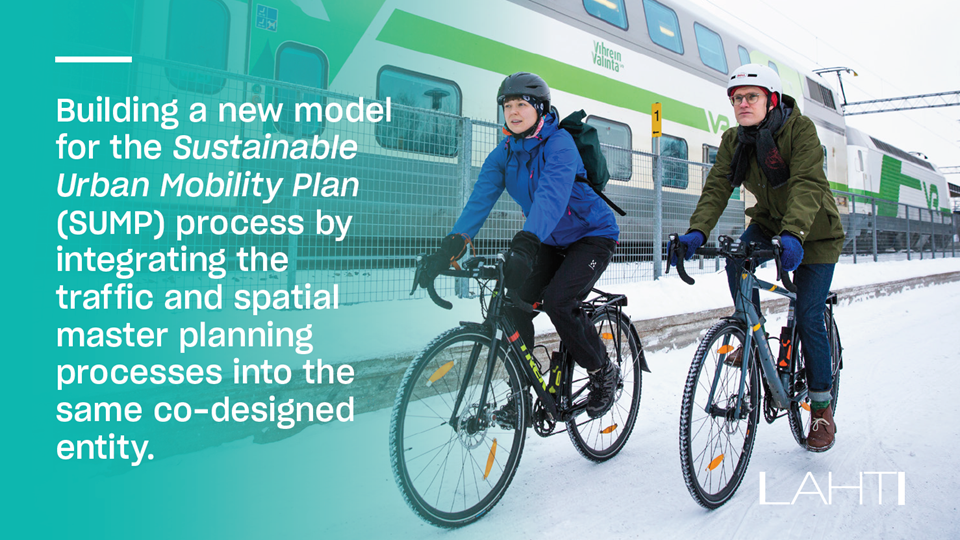
The work on the Lahti Direction aims to solve the question of how to ensure the residents' welfare and the sustainability of their everyday lives. What kind of a city would they like to live in in 30 years? What kind of lifestyles might the city’s children or grandchildren choose or want? In what direction should Lahti develop? These are some of the questions for which the city needs to find answers together with its citizens which the Master Plan aims to solve. Lahti's Direction can therefore be viewed as a forum for discussing the future development of the city, in which everyone plays an important role.
In 2011 Lahti needed a new approach to its master planning. Previous efforts were in legal limbo, a widespread problem for municipalities because in Finland, at the time, around 1100 master plans prepared each year, 9% end up in court, 75% of the time they brought about by citizens. Lahti was of the view that better communication of the benefits of proposals would win over citizens so they decided that for the next planning cycle the city would focus on better “marketing”. What started out as a marketing approach, quickly turned into a co-creation approach with citizens actively taking part in the end solution. The final outcome was seen as being a success in that it was developed faster, better and cheaper. The city understood that the best way was not to sell the idea but to work with citizens. A direct result of this shared experience, the city declared co-creation of all city service development.
Today, the city’s strategic Master Plan is updated every four years, or each council term. As soon as the plan is ratified by the city council, planners start to revise it according to the goals set by the new city council. Each newly elected council determines the goals for the new plan and approves the final plan during the last year of its term. This is meant to increase the flexibility of the master plan as a land-use planning tool, as well as its relevance and ability to address pertinent city issues. The city planning department is responsible for the planning process and for making the plan, but the process also involves city officials from other fields of city administration and policy areas. In addition, citizens have a chance to voice their views on the plan at various stages throughout the process.
The new round of planning started in 2017 and the finished plan will be approved in 2020. The Master Plan is the image of the strategy and it states what Lahti’s common goals mean from the perspective of land use and other policies impacting the whole city. The other programmes included in the work on the Lahti Direction stipulate the city’s goals and draws up action packages for sustainable urban mobility, environmental policy and the organisation of services. The target year is 2030, but impacts will extend beyond that. Under the CitiCAP project the SUMP process is being integrated into this cycle for the first time. This is viewed externally as being a unique policy and a forerunner in a Finish context as not many cities combine city strategy work on SUMPs with strategic master planning in an iterative process and offers unique insights how institutional frameworks for statutory planning can be used as a resource for strategic policy making.
During each four-year cycle of the Lahti Direction process, residents of the city are invited to participate in the planning for example at workshops or via surveys. As such, co-creation with citizens is an essential aspect of strategy development. The master planning work 2017–2020 begin with a charting of people’s needs by conducting surveys. One of the goals is to outline the distinctive zones of the city: nature, the rural areas, villages and parts of town as well as the urban area. By working on four-year cycles it provides a holistic approach to strategic land use, enabling the appropriate timing and targeting of more detailed city planning and building projects on a regular process.
Planning the trackside and railway station areas will play a significant role in the current master planning round. The urban economy, services, natural environments and built environments are relevant themes in the coming years. An electronic geographical information system (GIS) enables continuous planning work and is fundamental to the development of the plan. The knowledge gathered by the residents is also saved in the city’s GIS system. The progress of master planning is monitored using 20 ecological, social and economic measures. During each Master Plan cycle, various impacts of the proposed plan are assessed (e.g. walking and cycling, children, climate change and ecological networks) by city officials and qualified academic experts.*
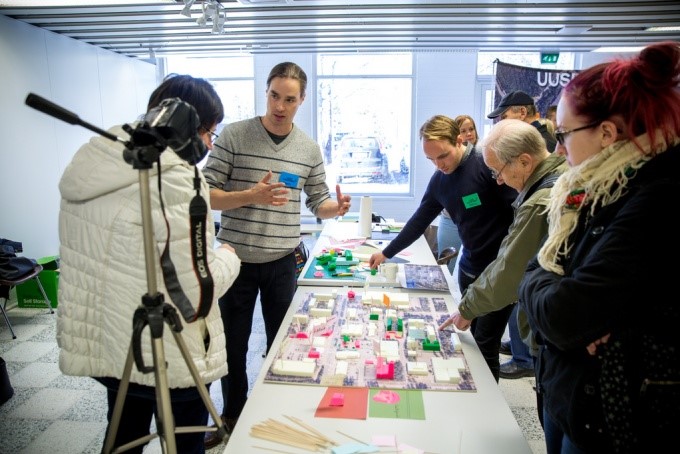
The challenge for CitiCAP is to stop the increase in traffic emissions so a special emphasis has been placed on integrating a SUMP into the master planning process, which will create the analytic city-wide framework for cutting CO2 emissions from the traffic sector to 2030, e.g. improving the bicycle infrastructure, finding smarter and low-carbon solutions for public transport and increasing pedestrian-friendly spaces in Lahti's urban cores.
The SUMP development plan has run over the same 2017-2020 timescale as the master planning process which will help cooperation across different policy areas, across different levels of government, and with local residents and other principal stakeholders, which lies at the heart of what SUMPs try to achieve:
- 2017: Analysation of the present state, setting of vision and targets.
- 2018-2019: Efficient action plan.
- 2019: Responsibilities and financing, monitoring and evaluation.
- 2020: Introduction and communication, lessons to be learned for the next round.
This is the first time that the city has integrated the two approaches together and the figure 1 below highlights how the two have run alongside each other.
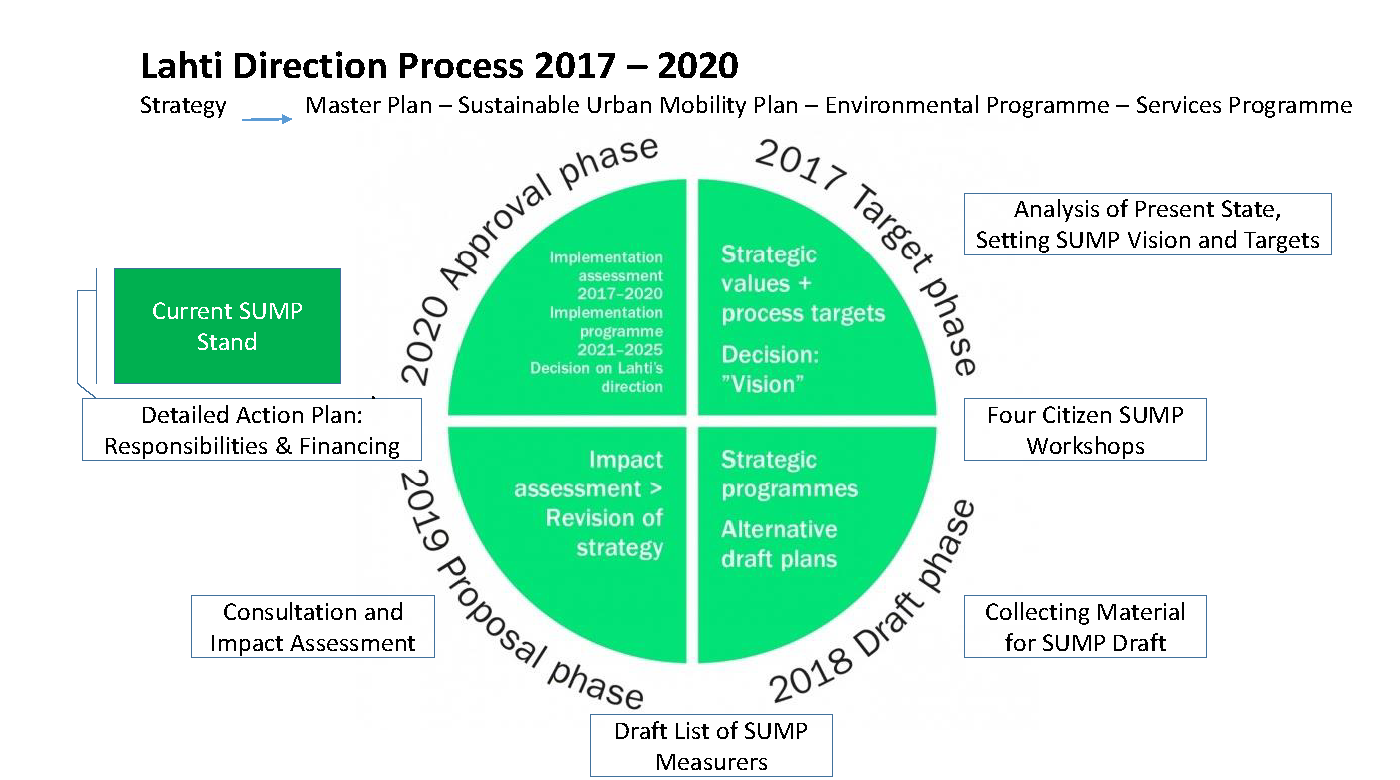
Why integrate the SUMP & Master Planning process
The importance of integrating the two approaches is that it helps to align land use and transport planning decisions; this is because urban land use and transport are closely interlinked. The separation of homes, shops and places of work creates the need to move goods and people. Conversely, the development of the transport system influences the location decisions of investors and households. Over recent years urban developments in the city have become more dispersed (partly due to better road links), locking a higher level of car dependency into the system. Evidence suggests that only a combination of coordinated land-use and transport policies will reverse this trend. By enhancing access to sustainable transport modes, the city is more likely to meet its environmental objectives but also enhance the quality of life and economic performance required to deliver on different city objectives, notably linked to the city’s Master Plan and SUMP objectives.
Another important element of this approach is that it will help to overcome different city policy silos and integrate mobility issues in the overall strategic management of the city. Part of the reason for this is because the Master Plan has the four year implementation process. By integrating a short term view of implementing the city’s policies with the long-term SUMP process, it helps Lahti embed the city’s broader policy process building a new path for initialising city policy around the city’s council cycle term.
It also helps to integrate the involvement of ‘interested parties’ in the transport and planning decision making process. This is because in Finland the Land use and Buildings Act mandatory requires this in the Master Planning process where as SUMP development is voluntary. By integrating the two approaches, it requires the engagement of decision makers which is key for implementation. Furthermore, as the Master Plan is designed to collect place-based data this can help mobility decision making of the city based on people’s accessibility needs. It also helps political buy-in into the process and outcomes as it allows decision makers to understand people’s buy-in to the process and vice versa as the four year cycle provides reassurance to citizens that issues can be resolved in the next planning cycle. This calls for continuous effort and work but the efforts can pay dividends, according to research undertaken on Lahti’s approach.
SUMP & Master Planning - the importance of collaboration
The latest SUMP Guidelines highlight the importance of co-creating a vision and strategy with stakeholders. In doing so it can help to create awareness and broad acceptance. As highlighted in figure 1, citizens were involved in developing the vision, e.g. via dedicated workshops. Sustainable Urban Mobility Planning outcomes can only be successful if citizens understand the vision and if they support its broader goals. The reason being, this can enable the process of using plans as an instrument to implement strategic policy and projects that truly benefit citizens. By integrating the two approaches for the first time, it allows Lahti to integrate the transport and planning process and the selection of solutions which is another key recommendation of the latest SUMP Guidelines (figure 2) and allows for a continuous Plan-Do-Check-Act process to be integrated into the city’s decision making.
Importantly, the Guidelines adopt a strong stakeholder engagement process attached to it which has been highlighted in figure 2 and by comparing the Master Plan process with the guidelines, it is clear that there are strong comparisons between the two approaches. Importantly, by integrating the SUMP alongside a mandatory planning process it provides a safeguard that supported mobility projects are in line with relevant city policies and forces the city to adopt key SUMP processes and practices in other areas. This is why it is viewed as being unique to Lahti and cited as a best practice approach in the latest SUMP guidelines. As such, it can help overcome barriers to perceived limitations to the planning and SUMP voluntary practices allowing for potential statutory reform in other cities so they can adopt a similar approach. This in turn can allow for the exchange of best practices, information sharing and raising awareness with other cities.
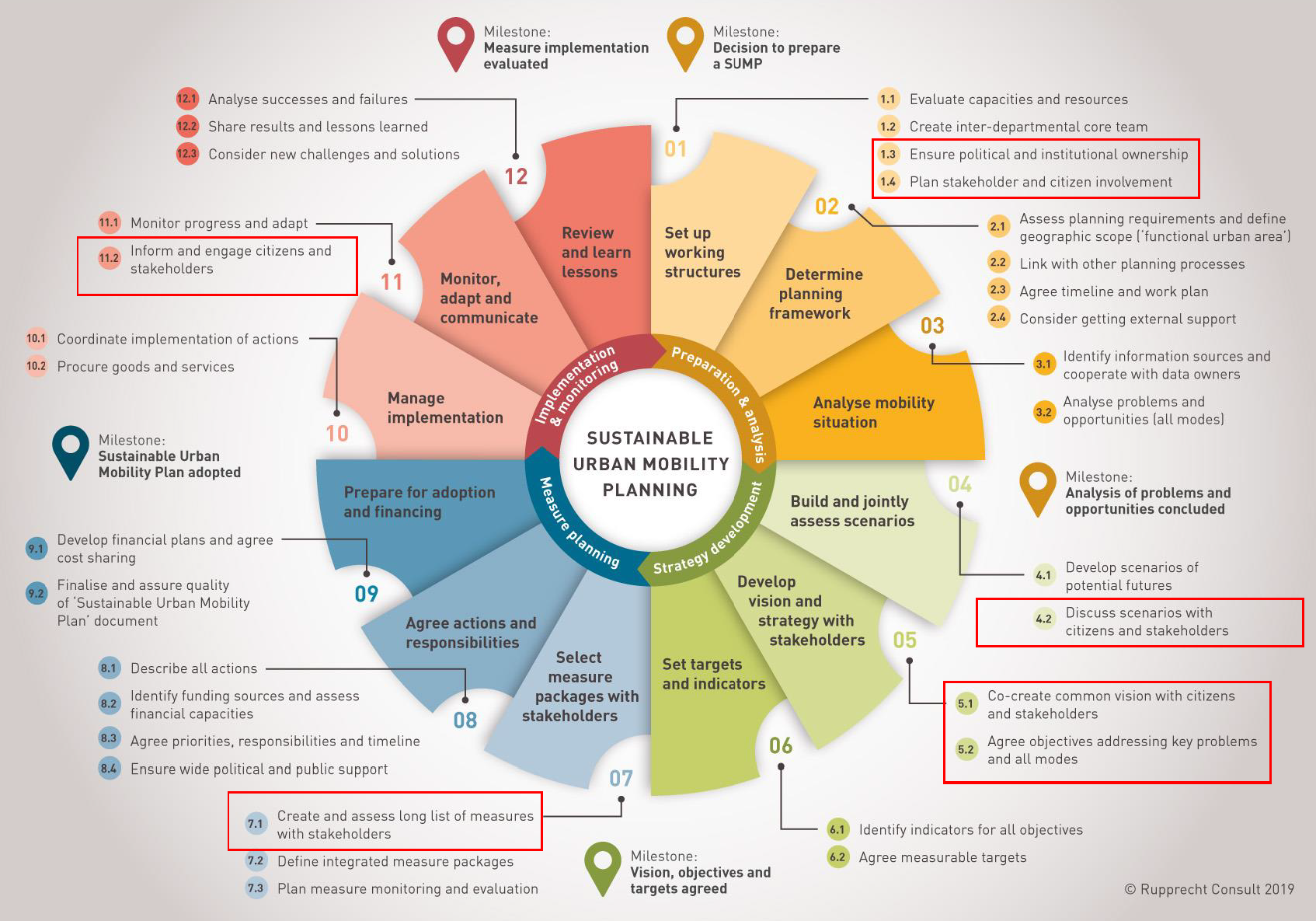
The CitiCAP project also has the difficult task of addressing the transport and climate conundrum. While adopting a co-creation process the city has also faced the following sources of conflicts:
- A lack of citizens’ involvement in wider public policy-making
- Existing conflicts within policy-making institutions
- Tension between economic interest and general interest and climate action;
- Different visions and interests on climate change actions but also solutions;
- Conflicts on the public communication and expertise on climate change; a lack of ambition of climate actions.
The city has however found that the co-creation process it has adopted has helped to overcome some of these initial problems and has helped the city move concepts towards holistic solutions which can help strengthening service provision for the benefits of citizens. The city has also found that co-creation collaboration is an important way to actively stimulate stakeholders and keep them motivated to deliver quality which is essential to the delivery of plans and overcome some of the conflicts outlined above. Furthermore, by developing a widely supported common vision it has helped to broaden the city’s perspective by looking beyond transport and mobility, and focus on the sustainability of cities as well as strengthen the local collective ownership of the vision of the city. This had helped emphasise the political value of a SUMP and ensure the commitment of key actors and decision-makers towards its delivery at the political level.
The additional benefit is that the better partners - citizens, cities, businesses and so on - understand, know and trust each other, the less they need formalised contractual agreements to underpin their collaboration; high trust leads to lower levels of formalisation than written contracts, and facilitates ad hoc coordination, something supportive of co-creation. This is very relevant to CitiCAP given the strong involvement of local businesses and SMEs in the project and helps to drive down costs.

The lessons learned are reflected in other cities and the following case studies confirm the value that it generates in the SUMP development process. They reflect Lahti’s experience that clear and honest collaboration with citizens can ensure the accurate management of participants so that they are engaged and bought into. This is why the co-creation aspect has been so fundamental to the project’s current success but is perhaps an overseen element which is why this Zoom-In has focused on this particular issue.
|
Case Study: With the expression of the importance to work towards climate neutrality, the signature of the Covenant of Mayors by Leuven’s mayor and the initiation of a consultation process, the city of Leuven created the association Leuven Climate Neutral 2030 (or Leuven 2030). This association provides guidance and the framework for defining a general long-term vision for the city. The association’s membership represents all sectors of society, with the municipality heavily involved in the process as well. The goal of reducing greenhouse gas emissions is also reflected in the local SUMP. It sets targets for doubling the modal share of cycling and public transport and reducing the use of cars in Leuven by 20% by 2030. Source: SUMP Guidelines 2.0 |
|
Case Study: To evaluate and discuss Munich’s Transport Development Plan and its objectives, stakeholders were given the opportunity to get involved in its development during numerous public events. This included a mobility workshop that drew approximately 100 attendees to share ideas on the future of the city’s mobility. The ideas were incorporated into the plan and thus set the direction for transport planning. A draft document was also circulated and allowed stakeholders to provide suggestions and highlight issues. Involving stakeholders in the process not only enabled Munich to find mobility solutions for everyone, but to also realise these solutions later. The city aims to increase the number of routes travelled by foot, bicycle and public transport and to quiet traffic in inner-city residential neighbourhoods. The city continues to incorporate citizens views from all ages into the co-creation of transport policy. Source: SUMP Guidelines 2.0 |
Conclusions and recommendations for CitiCAP
As mentioned in previous Journals, I have highlighted that active participation of stakeholders is essential to the success of the project. Indeed, if we are to see CitiCAP follower cities, they will need to see that citizens are brought into the project which the co-creation of government policies can help to achieve. If I were to recommend one thing to Lahti, I would suggest that there is a need to help citizens understand their role and place regarding climate change and transport but also to generate a culture of co-creation in all its city policies. Co-creation is a powerful concept: engaging broad stakeholders in a design or problem-solving process as co-designers. In fact, participatory design was actually born in the region and as such, it is fitting that co-creation features so prominently in the CitiCAP project.
What really matters is that all stakeholders (and this also means that the citizen and city does not exist as there are lots of different kinds of them) have the opportunity in the Master Plan / SUMP process get to understand each other's perspectives, possibilities and constraints - then a lot more becomes possible. This certainly does make for an interesting dynamic for CitiCAP.
References
Further to interviews with key members of the CitiCAP project, the following sources supported the collation and drafting of this Zoom In:
- A framework for stakeholder engagement on climate adaptation, CAF Working Paper, Gardner et al, 2018
- AS-Frabrik Project in Bilbao, UIA, 2019
- Brunet, Lucas & Tuomisaari, Johanna & Lavorel, Sandra & Crouzat, Emilie & Bierry, Adeline & Peltola, Taru & Arpin, Isabelle. (2018). Actionable knowledge for land use planning: Making ecosystem services operational. Land Use Policy.
- Co-creation: examples and lessons learned from south-east europe, ResearchGate, 2013
- Co-creation connectivity: addressing the citizen engagement challenge, Leading Cities, 2014
- Collaboration Across Boundaries Series - Engaging Citizens in Co-Creation in Public Services: Lessons Learned and Best Practices, IBM, 2013
- Engaging citizens in co-creation in public services: lessons learned and best practices, business for government, 2013
- Financing sustainable, resilient and inclusive solutions to attain SDGs 6, 7 and 11, Background Paper, United Nations, 2017
- Fishbein, M & Ajzen, ‘Belief, attitude, intention and behaviour: an introduction to theory and research’, Addison-Wesley, 1975
- Good practices and methods for co-creation, European Commission, 2017
- Guidelines for developing and implementing a Sustainable Urban Mobility Plan, 2nd Edition, Rupprecht Consult (editor), 2019
- Is participatory community co-creation the key to urban economic growth, Forbes, 2018
- Ownership of challenges and solutions in a co-creation process, SIC, 2019
- Paris Process on Mobility and Climate - COP25 Key Transport Messages, Slocat, 2019
- Policy making, implementation and innovation, European Commission, 2017
- Raine Mäntysalo, Johanna Tuomisaari, Kaisa Granqvist & Vesa Kanninen (2019) The Strategic Incrementalism of Lahti Master Planning: Three Lessons, Planning Theory & Practice
- Reaching the citizen: toolkit on effective communications and marketing, Civitas, 2011
- SET - the toolkit to engage citizens in co-creating their cities, European Innovation Partnership, 2018
- Territorial RFI Fostering Innovative Climate Action, European Commission, 2019
About this resource
The Urban Innovative Actions (UIA) is a European Union initiative that provided funding to urban areas across Europe to test new and unproven solutions to urban challenges. The initiative had a total ERDF budget of €372 million for 2014-2020.
Similar content




